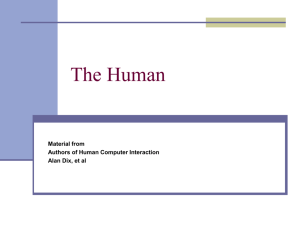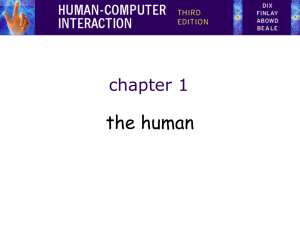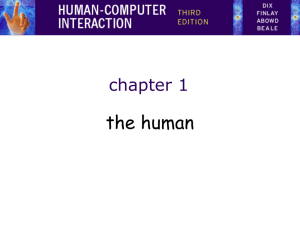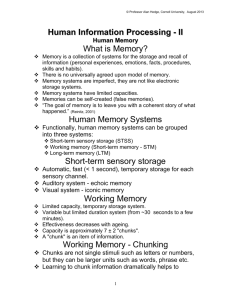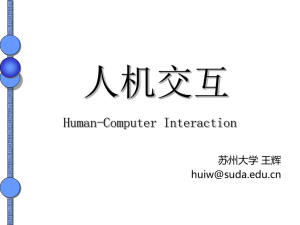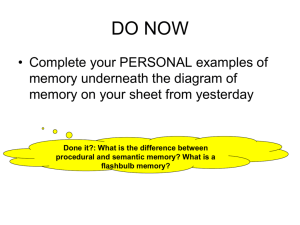P2.9_HumanMemory
advertisement
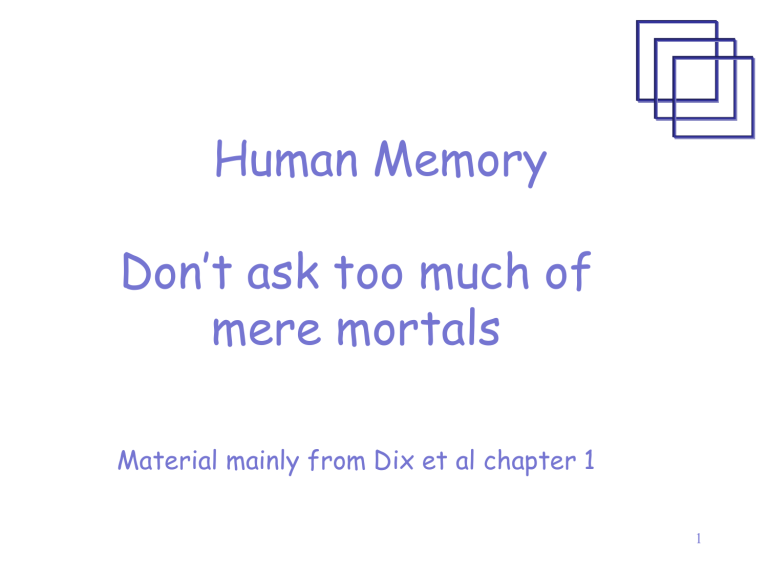
Human Memory Don’t ask too much of mere mortals Material mainly from Dix et al chapter 1 1 2 3 Learning outcomes • Describe the major categories of human memory • Describe the major organization structures of long term memory • How are these organization structures reflected in UI design 4 Memory There are three main types of memory function: Sensory memories Short-term memory or working memory Long-term memory Selection of stimuli governed by level of arousal. 5 Think about • What this means for HCI – – – – ? ? ? ? – We will come back to this at the end of the lecture 6 Sensory memory • Buffers for stimuli received through senses – iconic memory: visual stimuli – echoic memory: aural stimuli – haptic memory: tactile stimuli • Examples – “sparkler” trail – stereo sound • Continuously overwritten 7 Short-term memory (STM) • Scratch-pad for temporary recall – rapid access ~ 70ms – rapid decay ~ 200ms – limited capacity - 7± 2 chunks • Some research suggests that programmers have better short-term memory than ‘average’ people – This means you will have better short-term memory than your users! 8 A Chunk is 1 item in short term memory 212348278493202 0121 414 2626 HEC ATR ANU PTH ETR EET Microsoft product keys 9 Long-term memory (LTM) • Repository for all our knowledge – slow access ~ 1/10 second – slow decay, if any – huge or unlimited capacity • Two dominant types of access structure – episodic – serial memory of events – semantic – structured memory of facts, concepts, skills semantic LTM derived from episodic LTM 10 Interesting trivia • Mega memory techniques – Combine episodic and semantic • Experienced programmers – Use chunked techniques that they have used before to solve problems – They decompose the problem into bigger chunks than a novice programmer – Then apply known solution to each chunk – Takes about 10 years to build up repertoire 11 Long-term memory (cont.) • Semantic memory structure – provides access to information – represents relationships between bits of information – supports inference • Model: semantic network – inheritance – child nodes inherit properties of parent nodes – relationships between bits of information explicit – supports inference through inheritance 12 LTM - semantic network the human 2 of 3 13 Models of Long Term Memory Frames • Information organized in data structures • Slots in structure instantiated with values for instance of data • Type–subtype relationships DOG Fixed legs: 4 Default diet: carniverous sound: bark Variable size: colour COLLIE Fixed breed of: DOG type: sheepdog Default size: 65 cm Variable colour 14 Models of LTM - Scripts Model of stereotypical information required to interpret situation Script has elements that can be instantiated with values for context Script for a visit to the vet Entry conditions: dog ill vet open owner has money Result: dog better owner poorer vet richer Props: examination table medicine instruments Roles: vet examines diagnoses treats owner brings dog in pays takes dog out Scenes: arriving at reception waiting in room examination paying Tracks: dog needs medicine dog needs operation the human 2 of 3 15 Models of LTM - Production rules LTM is not only ‘facts’ it is also ‘rules’ Representation of procedural knowledge. Condition/action rules if condition is matched then use rule to determine action. IF dog is wagging tail THEN pat dog IF dog is growling THEN run away the human 2 of 3 16 LTM - Storage of information • rehearsal – information moves from STM to LTM • total time hypothesis – amount retained proportional to rehearsal time • distribution of practice effect – optimized by spreading learning over time • structure, meaning and familiarity – information easier to remember 17 LTM - Forgetting decay – information is lost gradually but very slowly interference – new information replaces old: retroactive interference – old may interfere with new: proactive inhibition so may not forget at all, memory is selective … … affected by emotion – can subconsciously `choose' to forget 18 LTM - retrieval recall – information reproduced from memory can be assisted by cues, e.g. categories, imagery recognition – information gives knowledge that it has been seen before – less complex than recall - information is cue spatial – Strong memory of where things are relative to other things 19 Applying this to your learning • • • • • Mind maps Pre-read Take notes Revise Look for connections between subjects 20 What does this means for HCI • Have you learnt anything new today? • What does this mean for hci? – – – – ? ? ? ? 21 Learning outcomes • Describe the major categories of human memory • Describe the major organization structures of long term memory • Describe how UI designs can make remembering easier 22
